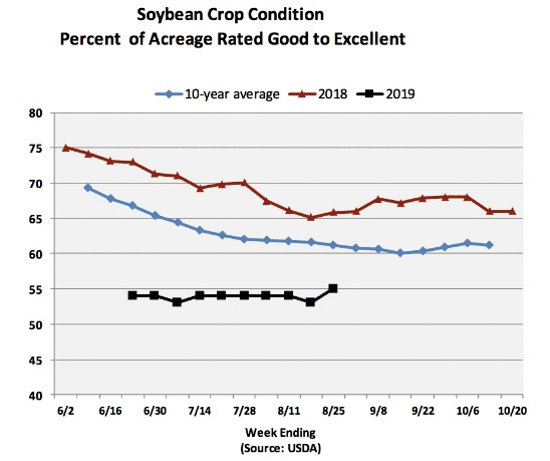By Rob Hatchett
The U.S. Department of Agriculture’s (USDA) National Agricultural Statistics Service (NASS) issued its last weekly update of U.S. crop ratings and development for August on Monday, the 26th. In the report, the portion of the 2019 soybean crop rated to be developing in either ‘good’ or ‘excellent’ (G/E) condition was slightly improved at 55%. This was up two percentage points from the previous week and topped the average of published trade expectations for a one-percentage-point increase. The improvement in ratings was driven largely due to a 10% increase in G/E for Illinois. Despite the tick higher, this year’s rating at 55% G/E is well below 66% the same week last year but is closer to the 10-year average of 61% G/E.

While it is somewhat of a relief to see a slight improvement in the crop condition rating, perhaps the biggest factor that the market must keep in mind is the considerable lateness of the 2019 U.S. soybean crop. The variability within this year’s soybean crop was a theme presented in the findings of last week’s annual crop tour, and the same information is reflected in USDA’s weekly crop development findings. The following chart compares the percentage of the 2019 U.S. soybean crop setting pods compared with last year’s crop and the previous five-year average to gauge the timeline for this year’s crop. On a national level, 79% of the soybean crop is setting pods compared with 94% in 2018 and the previous five-year average pace of 91%. Of the 18 reporting crops, it is particularly concerning to see that most of the largest delays this year are in Corn Belt states such as Illinois, Indiana, Michigan, Ohio and South Dakota. It is becoming increasingly more important for warmer weather to be accompanied by periodic showers in these states to help push the plants further along into pod setting before cooler weather slows the plants’ seed production. As the growing season advances, there will likely become a greater response to changes in temperatures for developing soybean crops.
Click here to see more...